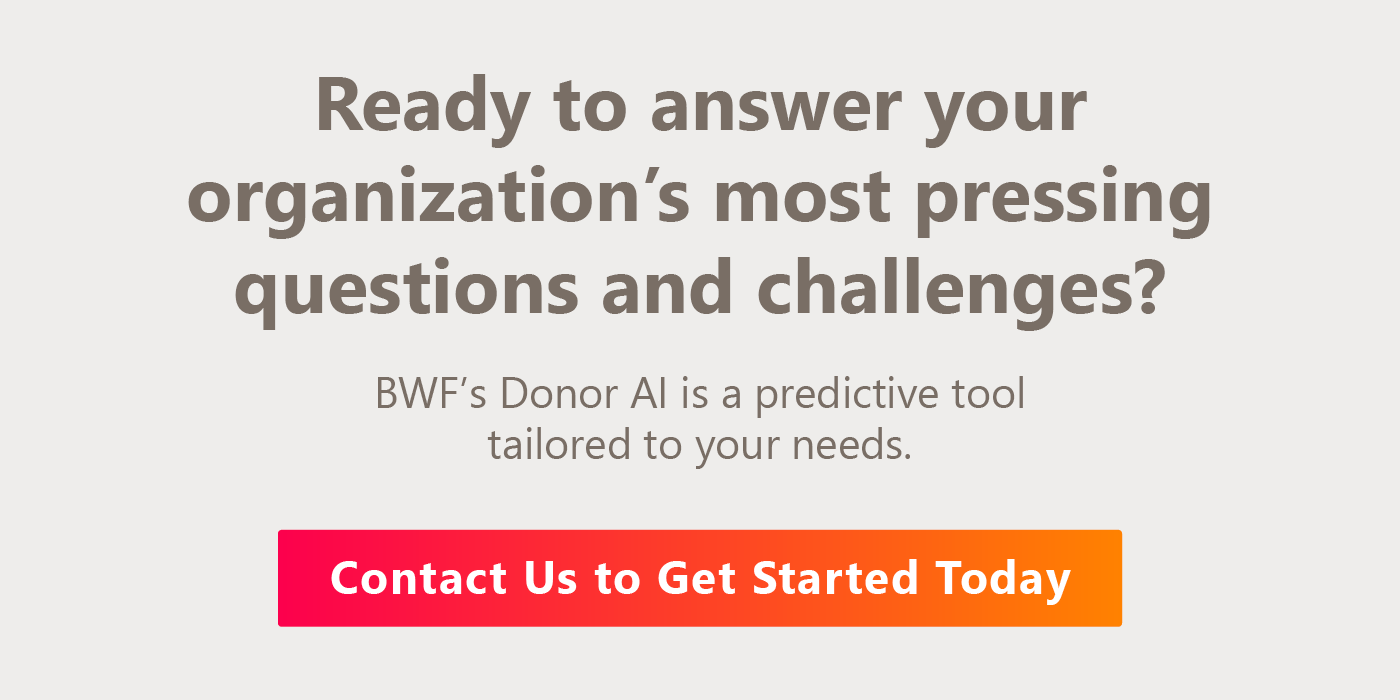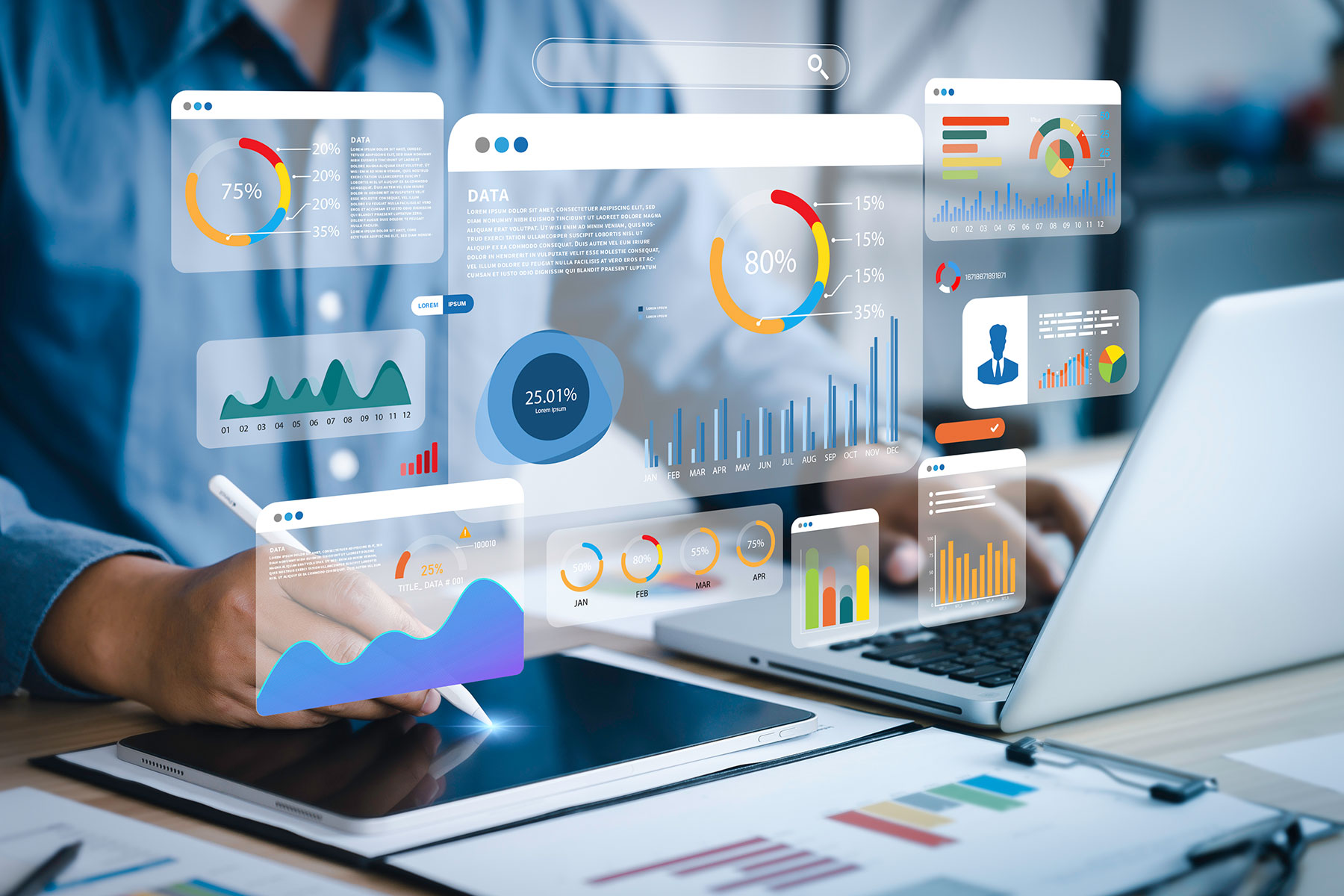The AI era of nonprofit fundraising is upon us—a Google.org study found that more than 50% of nonprofits now use AI solutions in some capacity.
However, according to a survey of nonprofits from Stanford University’s Institute for Human-Centered Artificial Intelligence: “About 80% of respondents who use AI deploy it for supportive work (finance, human resources, technology, communications, etc.), but only about 60% deploy AI for mission-related work (working with clients, implementing programs, or making grants).”
Predictive AI allows nonprofits to leverage AI solutions to solve issues directly related to their most important mission-driven activities, from fostering donor relationships to improving campaign return on investment (ROI). If you’re new to this type of data analysis, this guide will explore everything you need to know about predictive AI, including:
- What is predictive AI?
- How does predictive AI work?
- Predictive AI vs generative AI
- Predictive AI use cases
- How to streamline predictive analysis with Donor AI
The realm of predictive AI is evolving daily, but the tips in this post will help you get up to speed and prepare your nonprofit for long-term AI fundraising success.
What is predictive AI?
Predictive AI is a type of artificial intelligence that uses data, statistical algorithms, and machine learning to anticipate future outcomes based on past data trends. This analysis method empowers nonprofits to increase their fundraising return on investment (ROI) by making data-driven decisions based on information they know to be true about their donors.
How does predictive AI work?
Getting started with predictive AI requires thoughtful data preparation, a useful model, and continuous testing and improvement. Here is what the process looks like in a nutshell:
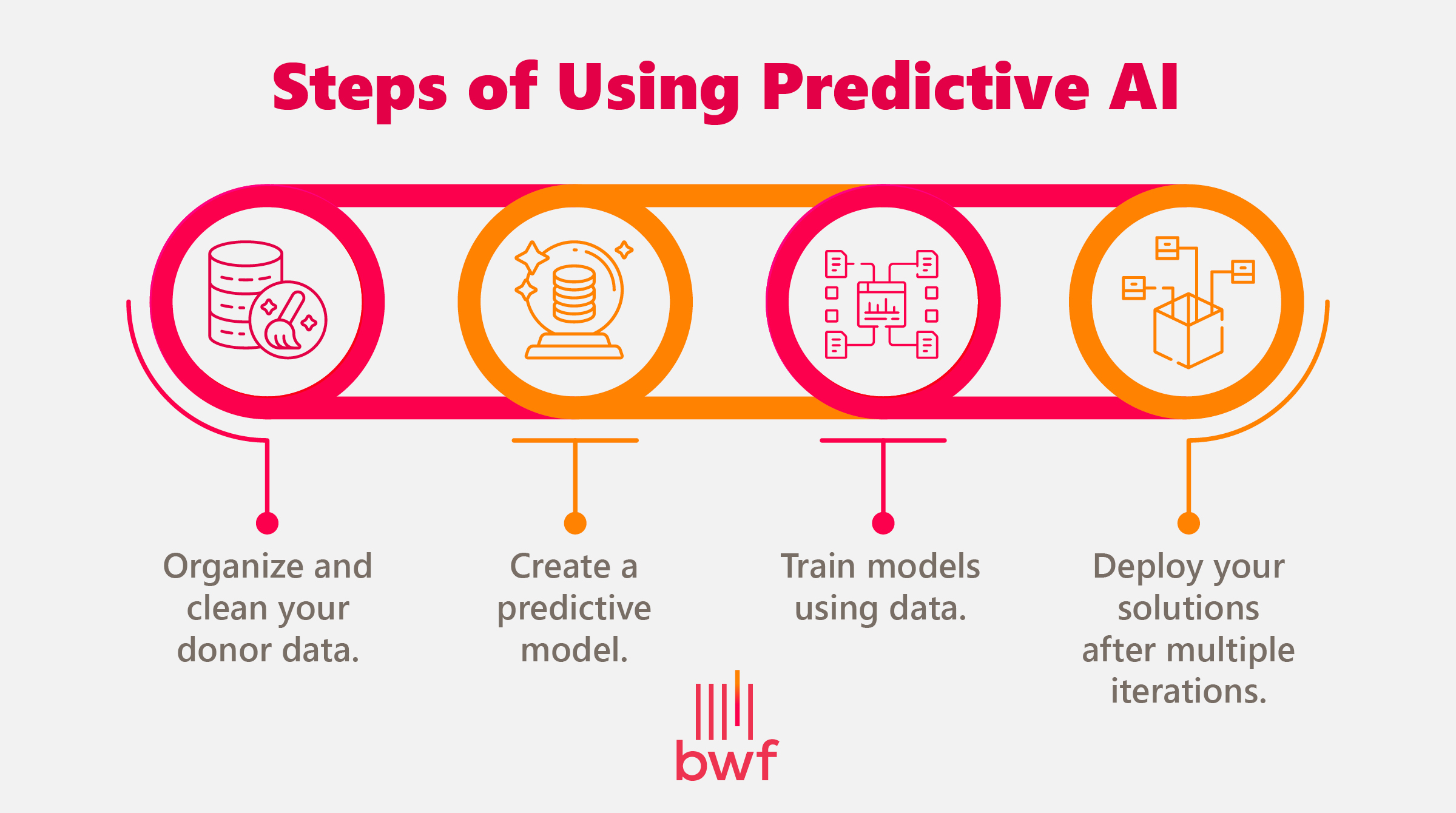
- Organize and clean your donor data. The accuracy of your predictive models relies on the internal donor data you use to train and test the projections. Before starting predictive analysis, audit your nonprofit’s database to ensure it’s organized and updated. Conduct data hygiene checks such as standardizing data entry procedures, eliminating or merging duplicate records, and reducing the buildup of unneeded data by streamlining donor-facing forms.
- Create a predictive model. Tools such as IBM’s watsonx.ai can help you build a predictive model based on your unique data. However, your organization may not have anyone on staff with the level of analytics expertise needed to build predictive models. In that case, you can work with a data analytics partner, such as BWF, to support your modeling process. BWF offers custom predictive modeling solutions tailored to your organization’s unique needs. Learn more about our services below.
- Train the models using your data. Next, you (or your data scientist) will enhance your model with the help of training and testing data. As explained in the chart below, training data helps give your models the information and context they need to generate accurate predictions. Testing data is added to your AI solutions to determine how effectively your models work when fed new data.
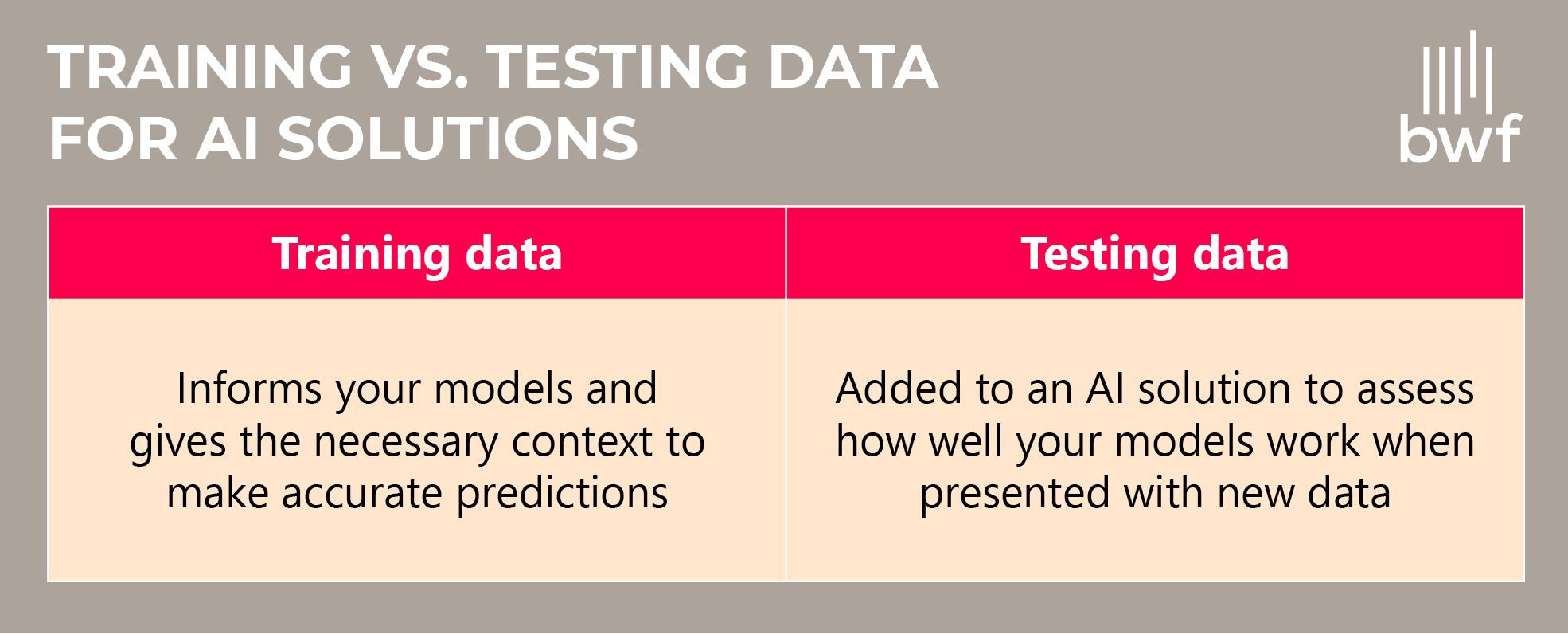
- Deploy your solutions after multiple iterations. Run your models through multiple rounds of training and testing to ensure they can produce the accurate results you need to inform your fundraising decisions. Ensure your IT team is involved in every step of the rollout to work through any obstacles.
Set metrics-related goals based on the processes you’re modeling to measure your models’ effectiveness. For example, if you’re creating a model to anticipate donor renewals, you may track your donor retention rate after implementing the next steps recommended by the model. If you’re predicting your marketing success on different social media platforms, you could track engagement metrics such as likes and shares.
These data points will give you a better sense of whether your models are helping you reach your ultimate goal of engaging and retaining more donors.
Predictive AI vs generative AI
Generative AI is another type of artificial intelligence you’ve probably heard of. Both generative and predictive AI use machine learning, but they differ in the types of data inputs they require:
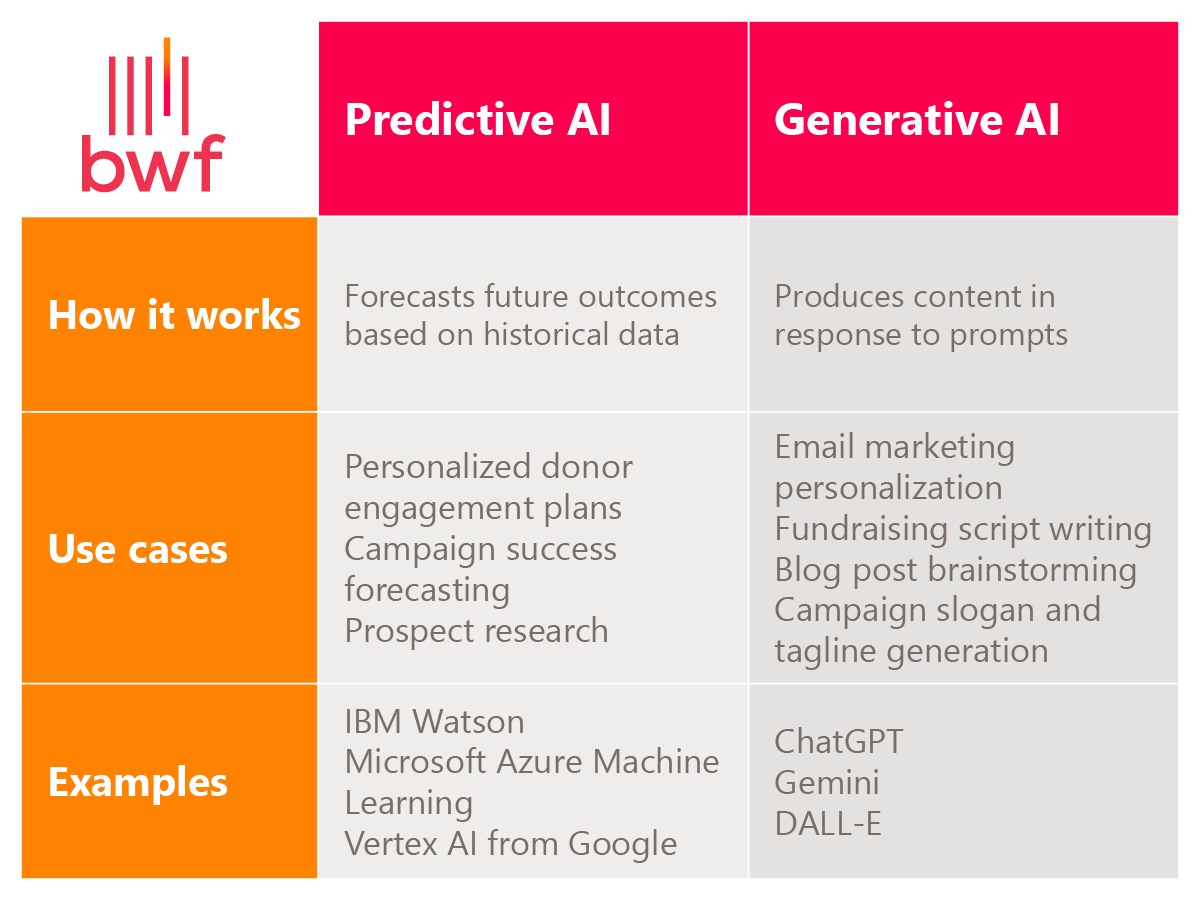
- Predictive AI seeks to forecast future outcomes based on historical data. Predictive AI use cases run the gamut, from creating personalized donor engagement strategies to forecasting campaign success. Examples of predictive AI solutions include IBM Watson, Microsoft Azure Machine Learning, and Vertex AI from Google.
- Generative AI produces content in response to prompts. Generative tools can create text, images, videos, and even music. Generative AI can support a wide range of nonprofit activities, including email marketing personalization, fundraising script writing, blog post brainstorming, campaign slogan and tagline development, and more. Examples of these tools include ChatGPT, Gemini, and DALL-E.
Both AI types offer benefits to nonprofits, such as reducing manual workloads and allowing team members to spend more time on big-picture fundraising strategies. They also come with similar ethical and security considerations. For example, using both generative and predictive AI tools requires your nonprofit to set clear data use and privacy policies to ensure all supporter information is handled securely.
In addition, you must actively combat bias and promote diversity when using both of these solutions. AI tools have the potential to perpetuate inherent biases if they’re trained using datasets that aren’t reflective of your community’s diversity. Ensure any systems you use actively identify and eliminate potential biases to promote inclusivity in your fundraising efforts.
Predictive AI use cases
You can deploy predictive models in a variety of ways to support your nonprofit’s fundraising and donor engagement goals. Let’s look at a few of the most beneficial use cases.
Personalized donor interactions
Predictive AI can help you develop tailored donor outreach approaches based on each donor’s past interactions with your organization. Use predictive AI to help with the following efforts:
- Audience persona creation. Create personas for different audiences based on data such as demographics, giving priorities, past gift amounts, and other forms of engagement like volunteering. Use your predictive models to develop between three and five primary personas for your core audiences. For example, you could create personas for small, mid-level, and major donors. You could also create personas based on programs donors are involved in, such as monthly or planned giving.
- Tailored donation request amounts. Donors will be much more receptive to donation requests that respect their giving capacity. Anticipate donors’ likely next gift amount by adding past donation data to your predictive model.
- Major and planned donor identification. Add wealth data such as stock ownership, real estate holdings, and past gift amounts to your models so that you can identify potential major or planned donors that exhibit these indicators. This empowers you to spend more time stewarding your most likely prospects, increasing your ROI.
65% of consumers say they’ll stay loyal to a brand that offers a personalized experience. Predictive AI helps deliver the customized experiences that today’s donors are looking for.
Engagement campaigns
Reaching donors on the communication platforms they use the most is essential to getting your message to stick. Predictive AI can help you choose the right marketing approach based on donors’ habits and preferences. That way, you can target donors using tailored:
- Messaging. Determine what messaging styles and tones resonate with donors the most by analyzing historical marketing performance data. For example, you can input data such as email open rates for different subject lines or pageviews for different blog post topics. Then, your model will help determine which efforts engage your audience most effectively.
- Channels. Use your modeling tools to determine which communication channels audience members prefer, such as email, social media, text messaging, your website, or direct mail.
- Communication frequency. Figuring out how often your donors want to hear from you is key to creating a positive supporter experience. You can model effective communication frequencies for different personas or individual donors (such as major donor prospects).
Striking the right balance between over and under-communication is critical for keeping your audience engaged. Predictive AI makes it easier to determine when and how to reach out to your audience.
Business forecasting
Predictive models can help determine how external factors will impact your nonprofit’s future performance, helping you mitigate risks and better prepare your organization to navigate challenging situations.
Nonprofits have faced tumultuous external circumstances over the past four years, with challenges ranging from the global pandemic to economic fluctuations and international conflicts.
According to Giving USA 2024, charitable giving decreased by 2.1% from 2022 to 2023 (when adjusted for inflation). However, positive indicators such as an invigorated stock market, a resilient economy, and strengthening ties between nonprofits and corporations all speak to a strong potential for the nonprofit sector to see significant growth.
Your predictive models can help determine whether your nonprofit needs to invest in or reorganize internal structures such as staffing or resource allocation to better respond to external opportunities and challenges.
Campaign success analysis
Campaigns are a highly successful fundraising strategy, but they require large amounts of your nonprofit’s time and resources. You can help predict your campaigns’ success by using modeling tools to anticipate your ROI. This strategy can help you assess the potential impact campaigns can have on the following types of giving:
- Principal giving
- Planned giving
- Annual giving
- Long-term investments or projects
Forecasting potential campaign success is an effective way to determine what campaign types are right for your organization, when to launch those campaigns, and how to go about planning them.
Healthcare and higher education fundraising
Predictive AI can support higher ed and alumni giving as well as healthcare fundraising and grateful patient scoring. Grateful patient scoring is the process of identifying likely donors within your pool of existing healthcare patients. Alumni fundraising is similar, but it focuses on identifying prospects from within your audience of former students. You can use the following indicators to identify your top prospects for each of these types of fundraising:
- Past experience with your organization as a patient or student
- Volunteer involvement
- Past gift amounts and campaigns supported
- Giving capacity as identified through wealth markers
Creating profiles for grateful patient or alumni donors can help you evaluate individuals in your database to see if their characteristics align with your top prospects.
How to streamline predictive analysis with Donor AI
If you’re looking for a customized predictive AI solution built for your organization’s needs, BWF has the tools and expertise you need. BWF’s Donor AI service combines the BWF team’s decades of data science expertise with IBM Watson’s industry-leading AI technology. As a result, your organization can use data-driven predictions of the outcomes of future events or campaigns to inform your strategies.
BWF empowers organizations with multiple packages depending on their needs
- Pipeline development
- Campaign optimization
- Engagement and building a donor base
- Healthcare fundraising
- Membership growth
You can build your own package by leveraging specific models depending on your needs, or you can choose our Essentials plan with pre-engineered predictive AI. The Essentials package includes models for major giving, planned giving, reacquisition, and renewals.
No matter which option you choose, you’ll receive ongoing insights based on your organization’s unique data that you can use to adjust your strategy for more successful fundraising.
Benefits of Donor AI
Donor AI gets to work for your organization immediately, offering the following benefits:
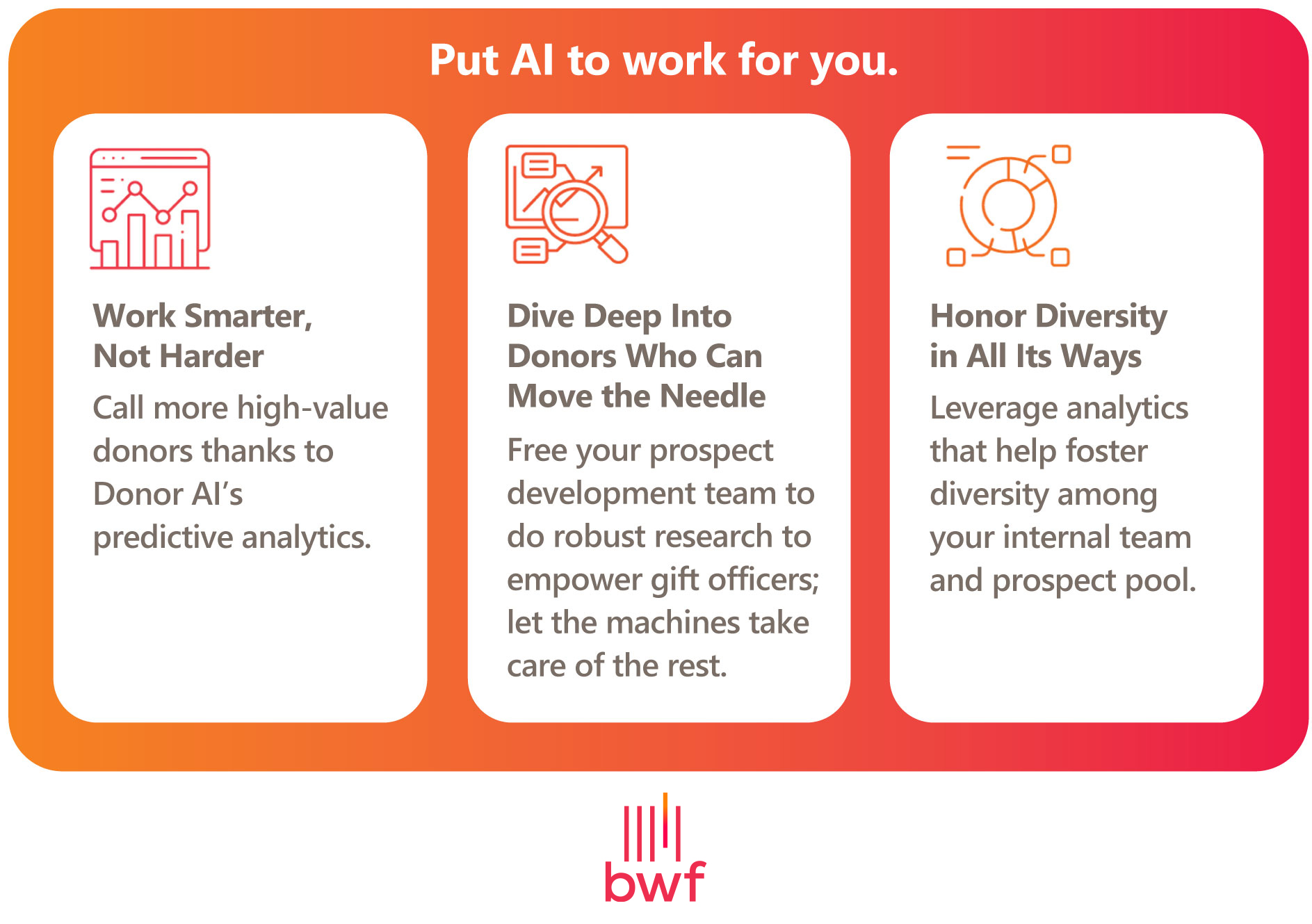
- Work smarter, not harder, by identifying more high-value donors and connecting with them faster.
- Give your prospect development team more time to conduct comprehensive audience research and empower your gift officers.
- Foster diversity and inclusion among your donor pool and your organization’s internal team.
Interested in learning more about this service? Watch the video below for more information or reach out to our data scientists today to discuss your predictive AI needs.
Wrapping up
Fundraising may feel like an unpredictable experiment where your organization tests a variety of hypotheses to see what works best. Predictive AI takes some of the guesswork out of the fundraising process, leaving your nonprofit with actionable, data-driven insights based on real donor behaviors and trends.
Want to learn more about nonprofit AI and BWF’s AI services? Start with these additional resources:
- The 2024 Nonprofit AI Quick-Start Guide: Tips for Success. Ready to get started with AI tools at your nonprofit? Discover the steps to launch your AI solutions in this guide.
- Fundraising Predictive Analytics: Expert Tips for Nonprofits. This comprehensive guide explores additional predictive analytics use cases and tips for updating your models.
- Donor AI For All – BWF. Learn more about BWF’s industry-leading predictive AI solution.
Let’s Talk
Find out how BWF can support your predictive AI strategies and goals.



